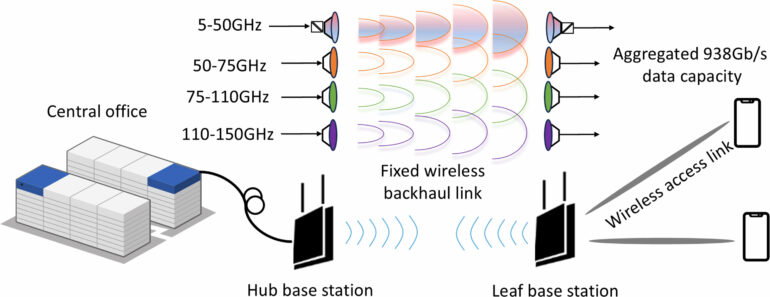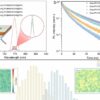A new world record in wireless transmission, promising faster and more reliable wireless communications, has been set by researchers from UCL.
The team successfully sent data over the air at a speed of 938 Gigabits per second (Gb/s) over a record frequency range of 5–150 Gigahertz (GHz).
This speed is up to 9,380 times faster than the best average 5G download speed in the UK, which is currently 100 Megabits per second (Mb/s) or over. The total bandwidth of 145GHz is more than five times higher than the previous wireless transmission world record.
Typically, wireless networks transmit information using radio waves over a narrow range of frequencies. Current wireless transmission methods, such as wi-fi and 5G mobile, predominantly operate at low frequencies below 6GHz.
But congestion in this frequency range has limited the speed of wireless communications.
Researchers from UCL Electronic & Electrical Engineering overcame this bottleneck by transmitting information through a much wider range of radio frequencies by combining both radio and optical technologies for the first time. The results are described in a study published in the Journal of Lightwave Technology.
This more efficient use of the wireless spectrum is expected to help meet growing demand for wireless data capacity and speed over the next three to five years.
Dr. Zhixin Liu, senior author of the study from UCL Electronic & Electrical Engineering, said, “Current wireless communication systems are struggling to keep up with the increasing demand for high-speed data access, with capacity in the last few meters between the user and the fiber optic network holding us back.
“Our solution is to use more of the available frequencies to increase bandwidth, while maintaining high signal quality and providing flexibility in accessing different frequency resources. This results in super-fast and reliable wireless networks, overcoming the speed bottleneck between user terminals and the Internet.
“Our new approach combines two existing wireless technologies for the first time, high-speed electronics and millimeter wave photonics, to overcome these barriers. This new system allows for the transmission of large amounts of data at unprecedented speeds, which will be crucial for the future of wireless communications.”
To address the current limitations of wireless technology, researchers from UCL developed a novel approach that combines advanced electronics, which performs well in the 5–50 GHz range, and a technology called photonics that uses light to generate radio information, which performs well in the 50–150GHz range.
The team generated high-quality signals by combining electronic digital-to-analog signal generators with light-based radio signal generators, allowing data to be transmitted across a wide range of frequencies from 5–150 GHz.
Impact on wireless technologies
State-of-the-art communications networks rely on several technologies to function. Optical fiber communications systems transmit data over long distances, between continents and from data centers to people’s homes. Wireless technology often comes in at the final stage, when data is transmitted a short distance, for example from a household internet router to the devices connected to it over wi-fi.
While optical fiber, which forms the backbone of modern communications networks, has made big advances in bandwidth and speed in recent years, these gains are limited without similar advances in the wireless technology that transmits information the final few meters in homes, workplaces and public spaces around the world.
The new UCL-developed technology has the potential to revolutionize various sectors, not least the wi-fi connectivity that people rely on at home and in other public places.
Mobile phone users can expect faster mobile internet speeds and more stable connections, with 5G and later 6G networks powered by this type of system. This would allow more people to use the network in densely populated urban environments or at large events like concerts without experiencing slowdown, or provide the same number of users with much faster speeds.
For example, a two-hour 4k Ultra HD film (around 14GB of data) would take 19 minutes to download over 5G at 100 Mb/s. Using the new technology, it could be downloaded in just 0.12 seconds.
Professor Izzat Darwazeh, an author of the study and director of UCL Institute of Communications and Connected Systems (ICCS) from UCL Electronic & Electrical Engineering, said, “The beauty of wireless technology is its flexibility in terms of space and location. It can be used in scenarios where optical cabling would be challenging, such as in a factory containing complex arrangements of equipment.
“This work brings wireless technology up to speed with the increased bandwidths and speeds that have been achieved with the radio frequency and optical communications systems within next-generation digital communications infrastructure.”
While the technology has only currently been demonstrated in the laboratory, work is underway to produce a prototype system that can be used for commercial testing. If this is successful, the technology will be ready to incorporate into commercial equipment within three to five years.
Professor Polina Bayvel, an author of the study, co-director of ICCS and Head of the UCL Optical Networks Group, said, “We are grateful to UKRI and the EPSRC for supporting this work to enable us to establish world-leading testbed and experimental capabilities in these areas. They are essential for the future of the UK’s national communications infrastructure, which is a critical resource.”
More information:
Zichuan Zhou et al, 938 Gb/s, 5–150 GHz Ultra-Wideband Transmission Over the Air Using Combined Electronic and Photonic-Assisted Signal Generation, Journal of Lightwave Technology (2024). DOI: 10.1109/JLT.2024.3446827
Provided by
University College London
Citation:
Engineers set new record on how fast data can be sent wirelessly (2024, October 16)



